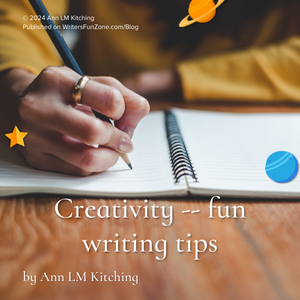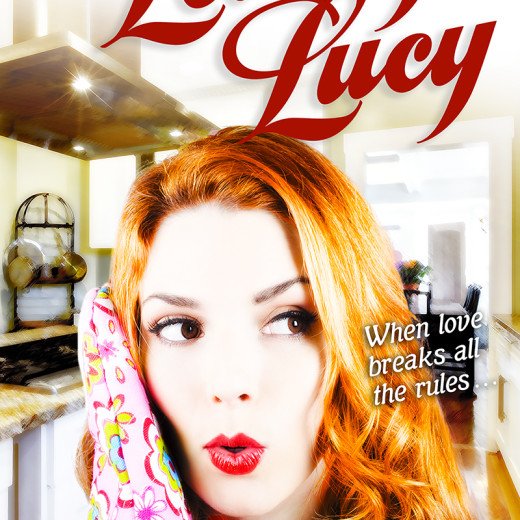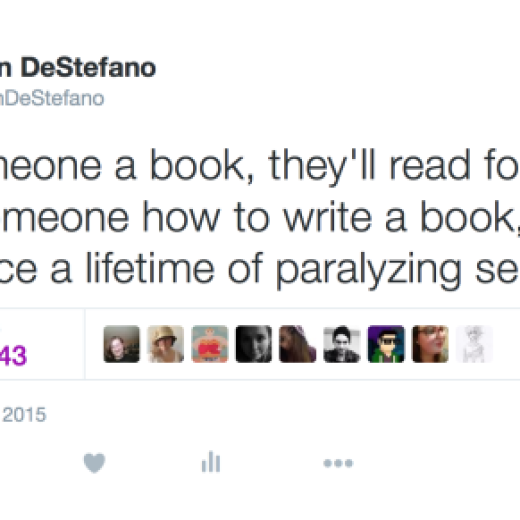Creativity — fun writing tips by Ann LM Kitching
 Today we welcome a new guest writer to Writer’s Fun Zone, Ann LM Kitching who is stopping by to chat with us about “Creativity — fun writing tips.” Enjoy!
Today we welcome a new guest writer to Writer’s Fun Zone, Ann LM Kitching who is stopping by to chat with us about “Creativity — fun writing tips.” Enjoy!
***
Writing’s Secret Sauce
Want to write a story as if you were preparing supper? Use a recipe–which in literary terms means a plot.
Free-writers/ Discovery Writers
A lot of writers find plots constraining. They seek the freedom to follow any tangents they desire. They don’t seem to care about wasted time or cutting thousands of words. They blurt their ideas onto the page and sop up the mess when they’re done.
Once their first draft is out of their head, they rewrite the story ten times or more to “get it right.” They throw spaghetti–and its special sauce–at the wall to see what sticks.
Writing to a Plan
As you can probably tell, I’m in the corner of writers who like a plan. In an article by LA Bourgeois, “On Perfectionism,” she says, “To find inspiration, we need to play and explore and let our curiosity lead us into unexpected places that may turn out to be nowhere special.”
Exciting thought–and perfect for the plotting phase.
Although I’m a fairly slow, methodical writer, I hate the idea of wasted scenes–worse, I hate crafting a scene that makes me laugh or cry just to cut it because it doesn’t fit the story.
Cutting great scenes breaks my heart, even if I understand why they don’t fit. My solution is to plot, test the plot, get the tangents out of my head, then write the story.
Using a Recipe
I cook like my mother: with a recipe open but neglected. I estimate measurements and use alternate ingredients according to what’s in the larder. Why should writing a novel be any different?
As a “discovery plotter,” I need a basic guide that allows flexibility. It’s important to know the foundations of what should hold the story together.
The events, characters, and settings change with every iteration, leading to an infinite story smorgasbord. How to develop such a recipe became an obsession.
Five Phases are All You Need
In search of a secret story recipe that leads to a satisfying read in multiple genres, five phases emerged as a stunning solution. All you need are an introduction, rising action, climax, falling action, and resolution.
Phase One shows a character with a problem in a setting. Develop the hero’s “normal” world so that readers understand what the character is like in familiar surroundings, and what she’ll lose if she takes on the opportunity/ quest/ change that presents at the end of this phase.
While the hero (meaning protagonist, but hero is easier to spell) is unhappy with the status quo and mostly unaware of a looming threat, the antagonist thrives.
His plans are underway and he may be completely oblivious to the hero.
If he knows the hero, he remains blithely unconcerned since she’s a minuscule menace.
The secondary characters close to the hero are more concerned with the overall threat but it seems far off.
They provide reasons for the hero to stay where she is but at least one of them will push the hero into the main conflict before she’s ready for it.
Phase Two shows the hero reeling from her decision to grasp the opportunity/ embark on the quest/ grapple with a change in circumstances.
No matter what she decides, she’s pushed into an unfamiliar situation that she’s unprepared to deal with.
She copes within her beliefs that she’s on the right path, but secondary characters around her underline how weak and unfit for the challenge she is.
She agrees, but the antagonist gets in her face and warns her off. That makes her believe she’s on the right path, and she digs in harder to defeat him.
Phase Three features a more intense confrontation between the hero and the antagonist.
The antagonist–who is bigger, stronger, smarter, “better” than the hero–wins.
The hero’s friends pull away because they lost to the antagonist, too, and they can’t bear to side with the loser hero. The hero reels from her loss. (Even if the hero wins what she wanted, she loses because she made mistakes.)
The hero concludes that her beginning strategy didn’t work, therefore, she needs to make changes.
Phase Four shows the hero scramble to make changes in her life. Most of her friends and family pull back; they don’t like the changes they see (plus, she didn’t protect them well enough against the antagonist; they don’t trust her anymore).
The antagonist turns angry because the hero wiggled away from the punishment he wanted to give her.
Instead of concentrating on his own goals, he targets the hero more directly. At the end of this phase comes the Dark Night of the Soul when the hero is completely isolated in a (metaphorical) dungeon.
Once again, she faces a choice: give up her new path and return to the start or commit to her quest and defeat the evil represented by the antagonist.
Phase Five introduces the final duel between the hero and the antagonist.
This time, because the hero survived her Dark Night, she wins.
If she rises on the side of evil, she joins the antagonist as his minion and destroys her new world.
If she rises in a positive arc, she regains her lost friends and the antagonist is banished to where he can do no more harm.
Add Your Own Flair
This recipe can be stirred again and again to bake fantastic new stories. For example, the book Easy Universal Plot showcases 45 five-phase plots and includes 19 samples.
Using a recipe doesn’t mean you have to follow it precisely the same way every time. Add peaches instead of apples, or ground almonds instead of flour. Mix up your writing to serve great stories to your readers.
***
ABOUT THE AUTHOR
 Ann LM Kitching, B.A., B.Ed., M.Ed., once wrote 86K-words… of drivel. She desperately needed someone to say what to write and when to write it. No one did, so she combined over twenty different plot techniques into one long format, then divided that into five repeating elements to make writing a novel straight-forward. She shares her techniques in her writing books and in classrooms.
Ann LM Kitching, B.A., B.Ed., M.Ed., once wrote 86K-words… of drivel. She desperately needed someone to say what to write and when to write it. No one did, so she combined over twenty different plot techniques into one long format, then divided that into five repeating elements to make writing a novel straight-forward. She shares her techniques in her writing books and in classrooms.






